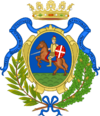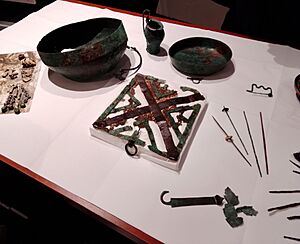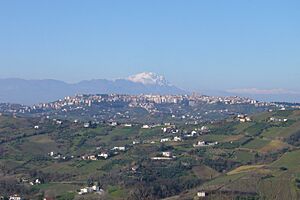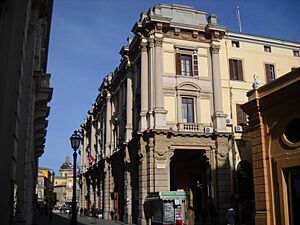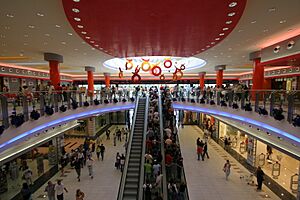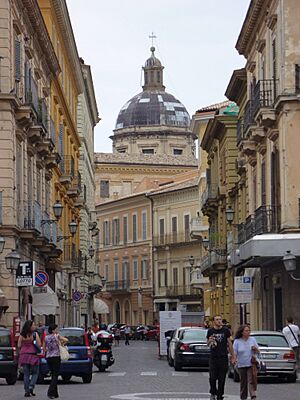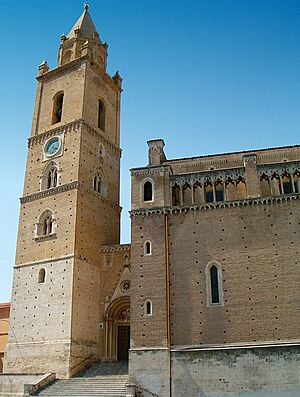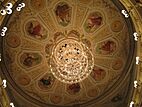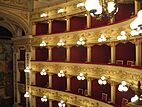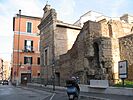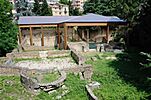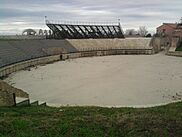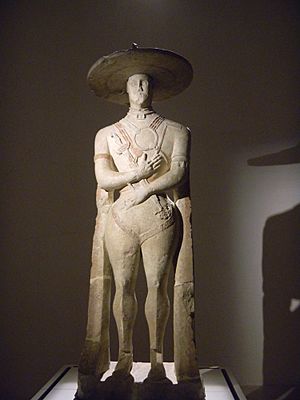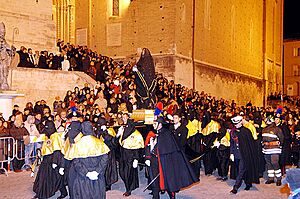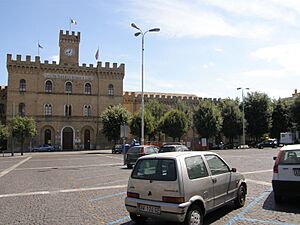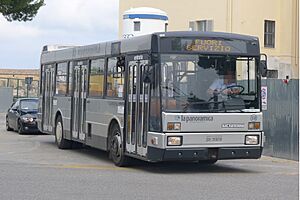Chieti facts for kids
Quick facts for kids
Chieti
Chjïétë / Chjìtë (Neapolitan)
|
|||
|---|---|---|---|
| Città di Chieti | |||
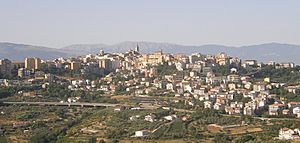
Panorama of Chieti
|
|||
|
|||
| Motto(s):
Theate Regia Metropolis utriusque Aprutinae Provinciae Princeps
|
|||
| Country | Italy | ||
| Region | Abruzzo | ||
| Province | Chieti (CH) | ||
| Frazioni | Bascelli, Brecciarola, Buonconsiglio-Fontanella, Carabba, Cerratina, Chieti Scalo, Colle dell'ara, Colle Marcone, Crocifisso, De Laurentis Vallelunga, Filippone, Fonte Cruciani, Iachini, La Torre, Madonna del Freddo, Madonna della Vittoria, Madonna delle Piane, San Martino, San Salvatore, Santa Filomena, Selvaiezzi, Tricalle, Vacrone Cascini, Vacrone Colle San Paolo, Vacrone Villa Cisterna, Vallepara, Villa Obletter, Villa Reale | ||
| Area | |||
| • Total | 58.55 km2 (22.61 sq mi) | ||
| Highest elevation | 348 m (1,142 ft) | ||
| Lowest elevation | 11 m (36 ft) | ||
| Population
(1 January 2023)
|
|||
| • Total | 48,455 | ||
| • Density | 827.58/km2 (2,143.43/sq mi) | ||
| Demonym(s) | Chietino Teatino |
||
| Time zone | UTC+1 (CET) | ||
| • Summer (DST) | UTC+2 (CEST) | ||
| Postal code |
66100
|
||
| Dialing code | 0871 | ||
| Patron saint | St. Justin of Chieti | ||
| Saint day | May 11 | ||
Chieti is an old city and a comune (which is like a municipality or town) in Southern Italy. It's about 200 kilometers (124 miles) east of Rome. Chieti is the main city of the province of Chieti in the Abruzzo region.
People from Chieti are called "teatini". This name is also used for a Catholic religious group called the Theatines.
Contents
- History of Chieti: A Journey Through Time
- Geography and Environment: Where Chieti Is Located
- Demographics: Who Lives in Chieti?
- Economy: How Chieti Makes a Living
- Landmarks and Culture: What to See and Do
- Education: Learning in Chieti
- Infrastructure and Public Services: Getting Around and Staying Healthy
- Media: Chieti on Screen
- Sport: Cycling in Chieti
- Notable People: Famous Faces from Chieti
- International Relations: Chieti's Friends Around the World
- See also
History of Chieti: A Journey Through Time
Ancient Legends and City Names
Chieti is one of Italy's oldest cities. Legends say it was founded by Achilles' friends, named after his mother, Thetis. Other stories suggest Greeks founded it after the fall of Troy, or even Hercules. The ancient writer Strabo said it was founded by people from Arcadia and called Thegeate.
The city was known as Theate (or Teate in Latin). As Theate Marrucinorum, it was the main town of the Marrucini, a strong warrior tribe.
Early Settlements: Traces from Long Ago
Scientists have found very old tools in Chieti, like hand axes. These tools show that people lived here as far back as 850,000 to 400,000 years ago. On Chieti's main hill, the oldest signs of human homes are from about 5,000 BC.
The Italic Period: Warrior Tribes
Around 1000 BC, the Marrucini tribe settled in the Chieti area. They were a strong Italic tribe who kept their own ways even after defeating other groups. They became part of the Samnites, a group of warlike people. The Marrucini lived in a small area, important for connecting to the Adriatic Sea.
Roman Times: Growth and Power
The Marrucini became loyal friends with the Romans after being defeated in battles. They gained Roman citizenship and their land became part of the Roman system. During Roman times, Teate grew to about 60,000 people. This was a very large number for that period!
The city had many important buildings, some of which you can still see today. These included a forum (a public square), a theater for 5,000 people, and an amphitheater for 4,000 people. There was also an aqueduct to bring water and thermae (public baths). Teate was important because of Via Tiburtina, a main road to Rome.
Christianity likely came early to Chieti, possibly because of this road. It is believed that Justin of Chieti helped organize the church here.
Medieval Era: Rebuilding and New Leaders
After the Western Roman Empire fell, Chieti was destroyed by invaders. It was later controlled by different groups like the Ostrogoths and Byzantine Empire. It became important again under the Lombards. In 801, it was destroyed again by Pepin of Italy, son of Charlemagne.
Chieti became important once more under the Norman rulers. The cathedral was rebuilt in 1069. New powerful families arrived, like the Valignani. In 1094, Robert Guiscard named Chieti the "capital of Abruzzi." In 1097, Pope Urban II called for the First Crusade from Chieti.
Later, Charles I of Anjou made Chieti bigger and added new walls. He also made Chieti the capital of a region called Abruzzo Citra. In the 14th century, the Cathedral was updated, and other churches were built. In 1443, Chieti was given the special title of "royal town and capital of both Abruzzo provinces."
Modern History: Changes and Challenges
In the 1500s, Chieti had strong trade links with Venice. Important families from other parts of Italy moved here. Gian Pietro Carafa, who later became Pope Paul IV, was a bishop in Chieti. In 1571, Chieti helped fight against the Ottoman Empire in the Battle of Lepanto.
After a time of great art and building in the 1600s, Chieti was hit hard by a plague in 1656. Many new religious groups came, building more churches and shaping the old town.
In the 1700s, Chieti gained more buildings and became a center for culture and learning.
Recent History: Unification and World War II
In 1806, Napoleon's France turned Chieti into a fortress. Many people from Chieti supported the Risorgimento, which was the movement to unite Italy. In 1860, Victor Emmanuel II visited Chieti, and in 1861, the city became part of the new Kingdom of Italy.
After Italy was united, Chieti saw many new things. These included banks, gas lighting, a railway station in 1888, electricity, and a new aqueduct.
Chieti sent many soldiers to World War I, and 350 people from the city died.
Chieti During World War II
During World War II, Chieti was declared an "open city" (like Rome). This meant it was not heavily bombed by either side.
However, it was the site of a POW Camp for British and Commonwealth officers (PG 21). Conditions at this camp were very difficult. It was often too crowded, with little water, poor sanitation, and no heating in winter. Food and warm clothes were scarce. Many prisoners passed through this camp.
After the war, some of the camp's staff were arrested for their actions.
The city welcomed many people seeking safety from nearby towns during the war. Allied forces freed Chieti on June 9, 1944, a day after the Germans left.
Geography and Environment: Where Chieti Is Located
Chieti is about 10 kilometers (6 miles) from the Adriatic Sea. In the background, you can see the Majella and Gran Sasso mountains.
The city is mainly divided into two parts: Chieti Alta (Upper Chieti) on a hill, and Chieti Scalo, a newer area with shops and industries. Chieti Scalo grew around the Chieti railway station in the Pescara river valley.
Chieti Alta is 348 meters (1,142 feet) above sea level. The top of the hill is flat and holds the old town with its historical buildings.
Geology: The Ground Beneath Chieti
The land around Chieti is mostly hilly. It's made up of layers of clays, sands, and gravels. These layers formed over millions of years, from about 5.3 million to 770,000 years ago.
Climate: Chieti's Weather
Chieti has a mix of humid subtropical and Mediterranean weather. It's humid all year. Winters are rainy or snowy and warm, while summers are hot and somewhat dry. Rain is common, especially in fall and spring. Snow can be heavy in winter, and temperatures often drop below freezing at night. Fog is also common in fall and winter due to high humidity.
Winds from the northeast bring cold air from the Eurasian Steppe. Winds from the southwest bring heat from the Algerian Desert. Wind is present throughout the year.
Natural Hazards: What to Watch Out For
Some areas in Chieti can have landslides, especially on steep hills during heavy rain. Floods can happen near the Pescara and Alento rivers.
Chieti is in an area with "average seismicity" (earthquake risk). There's a small chance of strong ground shaking in a 50-year period.
Wildfires are more likely from June to September, especially on vegetated slopes. Human activities often cause these fires.
Air Quality: How Clean Is the Air?
A report from 2021 showed that air pollution levels in Chieti Scalo were generally safe. However, the highest pollution levels in the Abruzzo region were found in Chieti and Pescara. Levels of PM 10 (small particles) and ozone sometimes reached higher points in summer, but stayed within legal limits. Other pollutants like benzene and carbon monoxide were well below limits.
Demographics: Who Lives in Chieti?
At the start of 2021, about 15.3% of Chieti's population was aged 0–19. People aged 65 and over made up 27.4%.
Also in early 2021, about 4.8% of the population (2,359 people) were not Italian citizens. The largest groups were from Romanians, Albanians, and Ukrainians. Most non-Italians were from European countries.
In 2016, the average income per person was €14,034. The unemployment rate was 16.02% in 2019, before the COVID-19 pandemic.
Language: The Local Dialect
The Abruzzo Adriatic dialect is still spoken in Chieti. Some language experts consider it a separate language.
Economy: How Chieti Makes a Living
Chieti is a city focused on culture and administration. Tourism is an important part of its economy. It is the capital of its province and has government offices, hospitals, and hotels.
Agriculture: Farming in Chieti
Agriculture is still a key part of the economy. Farmers grow vegetables, cereals, olives, tobacco, and grapes. The grapes are used to make famous wines like Montepulciano d'Abruzzo and Trebbiano d'Abruzzo.
Manufacturing: Making Things in Chieti
Chieti has many Manufacturing businesses. These include companies that make food, chemicals, clothes, building materials, and metal products.
Some important companies with offices or factories in Chieti are:
- Walter Tosto Spa: Makes products for many industries, including chemicals, oil, energy (even nuclear and renewable energy), and scientific research.
- Toto Holding Spa: Specializes in building roads and railways, and in renewable energy.
- Caffè Mokambo: A coffee company.
- SIAC Fashion srl (Rodrigo): A clothing company that sells worldwide.
- Leonardo: A large Italian company in aerospace, defense, and information security. They have a special security center in Chieti.
- Dayco: An American company with a presence in Chieti.
Real Estate: Buying and Renting Homes
In the first half of 2022, homes in Chieti Scalo were the most expensive, costing €880 to €1300 per square meter. The old town was slightly less expensive. Chieti Scalo also had the highest monthly rents.
Landmarks and Culture: What to See and Do
Historical Streets and Squares
Vittorio Emanuele II Square: The Main Hub
This is the main square in the old town, located on a part of Chieti's hill. It's also called Saint Justin Square or "Piazza Grande" (Big Square). Its official name honors Victor Emmanuel II of Italy, who visited Chieti in 1860 during the Italian unification.
The square features the Chieti Cathedral and other important buildings. These include the town hall and the tribunal. The town hall building was originally a palace from 1517, though it has been changed a lot over time.
Corso Marrucino: Chieti's Main Street
Corso Marrucino is the main street in Chieti's center. It follows the shape of the hill and has many buildings from different time periods, some with covered walkways. The street was made wider in the late 1800s.
Important buildings here include the old Bank of Italy building (early 1900s), the former Chamber of Commerce (1930), and the seat of the Province of Chieti (1914-1928). Older buildings include the former Piarists' boarding school, which is now a school, and De' Mayo palace. De' Mayo palace, from the 1500s, was once where the viceroy of Abruzzo lived. It has a large stone entrance and an interesting tower.
Churches: Beautiful Places of Worship
Chieti Cathedral: A Grand Old Church
The cathedral, dedicated to Saint Justin of Chieti, was likely built in the 700s. It was rebuilt several times, including in 840 and 1069. Only parts of the Romanesque crypt remain from the 1069 building. The church was decorated more in the 1300s and 1400s. Its bell tower was built in 1335 and 1498.
An earthquake in 1703 damaged the church, and it was changed again between 1764 and 1770. In the early 1900s, the outside was greatly modified. The crypt holds the remains of Saint Justin of Chieti. Next to the cathedral is a Baroque building, the Oratory of the Mount of the Dead Brotherhood, which is Chieti's oldest Catholic fraternity.
San Francesco al Corso: A Church with a History
This church, dedicated to Saint Francis, was probably founded in 1239. Its front was rebuilt in the 1600s. After years of neglect, a big restoration in 1689 changed its look. In the late 1800s, an outside stairway was added. The church has a dome with painted illusions and ten chapels, paid for by important families.
Santa Chiara: A Baroque Gem
The Baroque church of Santa Chiara was built for nuns between 1644 and 1720. It has a single main aisle. The building next door was once a convent for the nuns and is now a police center. The church has beautiful artworks, including a wooden pulpit with gold and marble, an 18th-century organ, and a ceiling painting of the Assumption of Mary.
Santissima Trinità: The Holy Trinity Church
This church, named after the Holy Trinity, was built in 1586-1587 by a brotherhood with donations from locals. It has a single main aisle and a brick front finished in 1609.
San Domenico: Along Corso Marrucino
San Domenico church is on Corso Marrucino street. It was built between 1642 and 1672. The front is in a Roman Baroque style with a brick bell tower. The inside is richly decorated and holds artworks from another church that was torn down.
Public Buildings: Important Structures
Teatro Marrucino: Chieti's Grand Theater
In the early 1800s, Chieti needed a bigger, more modern theater. So, they built a new one from 1813 to 1817. It was named "Saint Ferdinand" at first. It opened in 1818 with the opera La Cenerentola. After Italy was united, it was renamed "Teatro Marrucino" after the ancient Marrucini people.
In the 1870s, the theater was improved. A new upper balcony was added. The ceiling was decorated with a wooden rose window, flowers, and portraits of famous artists like Shakespeare and Verdi. In 1875, an artist painted the front curtain, showing a victory of Gaius Asinius Pollio.
Military Architecture: Old Defenses
Porta Pescara: The City Gate
Porta Pescara is the only remaining city gates of Chieti's old walls. One part dates back to the 1200s, and the other was built in 1797. The older gate has an elegant pointed arch. Their name comes from the fact that they led to the old road to today's Pescara.
Urban Parks: Green Spaces
Villa Comunale: Chieti's Main Park
Villa Comunale is the largest park in Chieti, located on the southern part of the hill. It was created by joining the gardens of two noble villas in the early 1800s. The park was opened to the public in 1868. Over the years, more land was added to create this large urban park. You can still see trees like lindens and cedars from Florence.
The park also has a fountain bought from a French exhibition in 1890, two artificial lakes, and a large bronze memorial for First World War soldiers. Next to the park is a former military hospital, which was once a convent founded in 1420.
Archaeological Sites: Discovering the Past
Chieti was once the Roman town of Teate. It was built in an area that had been lived in since prehistoric times. Today, you can see many Roman sites, including three temples, a theatre, an amphitheatre, thermae (baths), and underground cisterns (water tanks). In the citadel area, ancient pottery, statues, and temple decorations have been found.
Roman Theater: Ancient Entertainment
In the La Civitella area, you can see the remains of a Roman theater. It was likely built in the 1st century CE, a time when the city was doing very well. The theater was about 80 meters (262 feet) wide and could hold about 5,000 people. Today, you can still see parts of its seating area and some corridors.
Roman Temples: Sacred Places
In 1935, the remains of four ancient Roman temples were found. The best-preserved one has been used as a church since the 700s. Another temple was removed to build a post office. Two twin temples and a smaller one were built by Marcus Vetius Marcellus and his wife Helvidia Priscilla. We don't know which gods they were dedicated to, but some think they were for Jupiter, Juno, and Minerva. The walls were made of bricks and stone.
Subterranean Structures: Underground Secrets
The Roman baths are connected to an underground cistern, which was part of a large Roman water supply system.
Also, under the 18th-century Palazzo de' Mayo, there's an ancient Roman underground street called via tecta. It's over 4 meters (13 feet) tall, and its purpose is still a mystery!
Museums: Exploring Chieti's Heritage
- The National Archaeological Museum of Abruzzo is in a beautiful 19th-century building, surrounded by a park. It holds the famous ancient Warrior of Capestrano statue. The museum's rooms show Italic and Roman sculpture, old coins, and items from the Marrucini and other ancient tribes.
- The Archaeological Museum La Civitella is near the Roman amphitheatre. It focuses on the Marrucini tribe and Chieti's ancient history.
- The University Museum of History of Biomedical Sciences is run by the University of Chieti-Pescara. It displays prehistoric finds, rocks, minerals, shells, old medical devices, and contemporary art.
- The art museum dedicated to Costantino Barbella is in an 18th-century palace. It has frescoes, sculptures, paintings, and pottery from the 1400s to the 1900s, including pottery from Castelli.
- The Museo Diocesano Teatino (Diocesan Museum of Chieti) is in the 17th-century Church of Saint Dominic. It shows frescoes from the 1300s to the 1500s, wooden statues, and paintings.
Events: Celebrations and Traditions
Good Friday Procession: A Long-Standing Tradition
Some historians believe Chieti's Good Friday procession is Italy's oldest religious procession, dating back to 842. Its current form has been around since the 1500s. It is organized by the Mount of the Dead Brotherhood, an old local fraternity.
The procession includes sacred symbols, like an 18th-century wooden Christ sculpture and a statue of Our Lady of Sorrows. It starts at the Cathedral at sunset and moves through the main streets of the old town, lit by torches. Many people take part, including hooded members of brotherhoods, clergymen, and a choir and orchestra performing Miserere by Saverio Selecchy.
Education: Learning in Chieti
Chieti has many schools for all ages. There are state and private kindergartens, primary schools, and middle schools. For older students, there's a private secondary school and seven state secondary schools. These include technical institutes, high schools focused on science or classics, and an art high school.
The University of Chieti (Università G. d'Annunzio – Chieti e Pescara) has campuses in Chieti and Pescara. It has about 35,000 students studying subjects like Architecture, Arts, Economics, Medicine, Psychology, and Sciences.
Infrastructure and Public Services: Getting Around and Staying Healthy
Healthcare: Hospitals and Clinics
Healthcare in Chieti is managed by ASL Lanciano-Vasto-Chieti. This includes the main hospital, SS. Annunziata polyclinic, which has an emergency department. There are also two private hospitals, Villa Pini and Spatocco.
Transport: How to Get There
Public Transport: Buses and Trolleybuses
Public transport in Chieti is mainly provided by bus companies like Società Unica Abruzzese di Trasporto (TUA) and La Panoramica. La Panoramica runs urban bus lines, including the Chieti trolleybus system. TUA is a regional company that operates both bus and rail services.
Main Roads: Driving to Chieti
Chieti is connected by several important motorways:
- Autostrada A14: The "Adriatic Motorway" runs north-south. You can get on it at the "Pescara ovest - Chieti" exit.
- Autostrada A25: This motorway connects the Adriatic coast to Torano, providing a way to reach Rome from Chieti.
- Raccordo autostradale RA12: This road is part of the European route E80.
Other important roads connect Chieti to the surrounding areas:
- Strada statale 5 Via Tiburtina Valeria: A secondary road to Rome, named after the ancient Roman Via Tiburtina.
- Strada statale 81 Piceno Aprutina: Connects Chieti to Teramo.
- Strada statale 656 Val Pescara-Chieti.
Railways and Train Stations: Traveling by Train
Chieti Scalo has two train stations: Chieti railway station and the smaller Chieti–Madonna delle Piane railway station. These are on the Rome–Sulmona–Pescara railway, which also connects to the Adriatic railway. There's also a freight station nearby for a logistics center. An old railway that connected the old town and Chieti Scalo was closed in 1943.
Nearby Ports and Airports: Air and Sea Travel
Chieti is about 12 kilometers (7.5 miles) from Abruzzo Airport, the only international airport in Abruzzo. The main regional ports for merchant ships are in Ortona, Pescara, and Vasto.
Media: Chieti on Screen
Chieti is home to the main office of Rete8, a local television station that creates its own shows.
Luciano Odorisio, a film director born in Chieti, chose his hometown as the setting and filming location for his movies Sciopèn (1982) and Via Paradiso (1988). Chieti was also used for parts of the films Ambo (2014) and Omicidio all'italiana (2017).
Sport: Cycling in Chieti
The 6th stage of the 2024 Giro d'Italia Women cycling race finished in Chieti on July 12. Liane Lippert won that stage.
Notable People: Famous Faces from Chieti
Ancient Romans from Teate (Chieti)
- Asinia gens: A noble family from Teate.
- Herius Asinius: A military leader who fought against the Roman Republic.
- Gaius Asinius Pollio: A Roman military leader, politician, writer, and historian. He was a supporter of the famous poet Virgil.
- Lusius Storax: A wealthy freedman and politician, known for his tomb monument.
People Born in Chieti
Actors
- Lidia Broccolino
- Alessia Barela
- Giulia Di Quilio
- Giacomo Ferrara
Athletes
- Lorenzo Parente: Professional wrestler.
- Vittorio Visini: Race walker.
- Filippo Antonelli: Football (soccer) player.
- Gianluca Capitano: Cyclist.
- Stefano Mancinelli: Basketball player.
- Stefano Mammarella: Futsal (indoor soccer) player.
- Fabrizia D'Ottavio: Rhythmic gymnast.
- Giulio Ciccone: Cyclist.
Businesspeople

- Sergio Marchionne (1952 – 2018): Former CEO of famous car companies like Ferrari and Fiat Chrysler Automobiles.
- Pierluigi Zappacosta (born 1950): Co-founder of Logitech, a well-known computer accessories company.
Explorers
- Giovanni Chiarini (1849 – 1879): An explorer of Africa.
Film Directors
- Anton Giulio Majano
- Luciano Odorisio
- Lars Kraume
Fine Arts
- Giovanni Battista Spinelli: Painter.
- Costantino Barbella: Sculptor.
- Luciano de Liberato: Abstract painter.
Musicians
- Maurizio Colasanti: Conductor.
Politicians
- Antonio Nolli: Minister of Finance in the Napoleonic Kingdom of Naples.
- Augusto Pierantoni: A legal expert and member of the Italian Senate.
- Giovanni Pace: Former president of Abruzzo.
Religious Figures
- Illuminato da Chieti: A Franciscan friar.
- Alessandro Valignano: A Jesuit priest and missionary.
Scientists
- Giovanni Fortunato Bianchini (1719–1779): A physician and physicist.
Social Sciences and Humanities
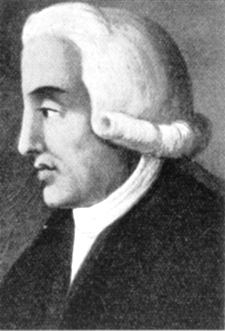
- Nicoletto Vernia (around 1420 – 1499): A philosopher.
- Girolamo Nicolino (1604 – 1664): A historian and legal expert.
- Niccolò Toppi (1607 – 1681): A historian.
- Ferdinando Galiani (1728 – 1787): A famous economist.
- Umberto Ricci (1879 – 1946): An economist and statistician.
- Ettore Paratore (1907 – 2000): A Latin scholar.
- Brunilde Ridgway (born 1929): An archaeologist.
Writers
- Federico Valignani
People Who Lived in Chieti
Fine Arts
- Francesco Paolo Michetti: Painter.
- Tommaso Cascella: Painter and ceramic artist who taught and worked in Chieti.
Humanities Scholars
- Joseph Allegranza: A Dominican historian and archaeologist.
Notable Bishops and Archbishops of Chieti
- Saint Justin of Chieti
- Oliviero Carafa: A cardinal and military leader.
- Pope Paul IV: Born Gian Pietro Carafa.
- Bernardino Maffei: A cardinal.
- Loris Francesco Capovilla: Personal secretary to Pope John XXIII.
- Vincenzo Fagiolo: A cardinal.
- Bruno Forte: A theologian and the current archbishop.
International Relations: Chieti's Friends Around the World
Chieti has "friendship pacts" with two cities:
 Trento, Italy: This agreement was signed in 2011. It remembers the soldiers from Chieti who were among the first to enter Trento on November 3, 1918, at the end of World War I.
Trento, Italy: This agreement was signed in 2011. It remembers the soldiers from Chieti who were among the first to enter Trento on November 3, 1918, at the end of World War I. Minamishimabara, Nagasaki Prefecture, Japan: This pact is based on the history of Alessandro Valignano, a Jesuit missionary born in Chieti. He arrived in Minamishimabara on July 25, 1579. Since 2011, the two cities have had cultural exchanges, and they signed an official friendship pact in 2016.
Minamishimabara, Nagasaki Prefecture, Japan: This pact is based on the history of Alessandro Valignano, a Jesuit missionary born in Chieti. He arrived in Minamishimabara on July 25, 1579. Since 2011, the two cities have had cultural exchanges, and they signed an official friendship pact in 2016.
See also
 In Spanish: Chieti para niños
In Spanish: Chieti para niños



